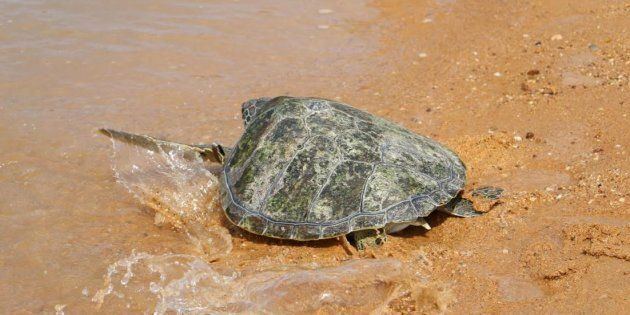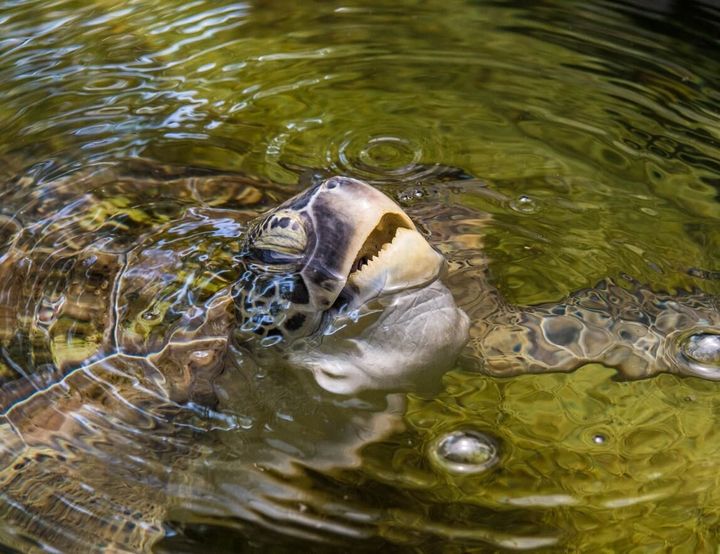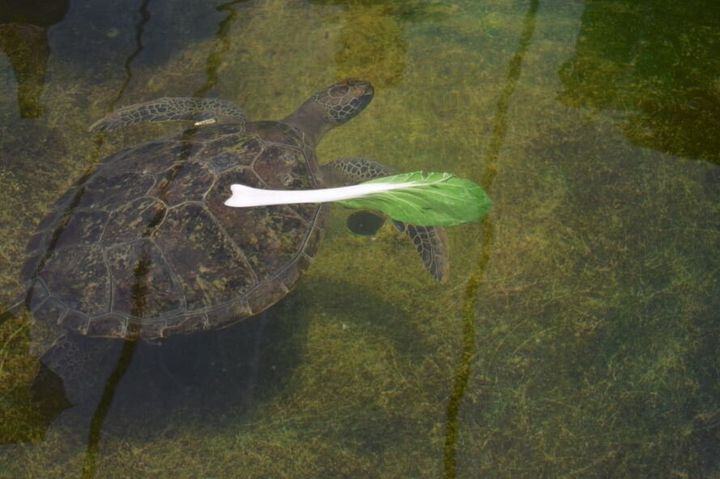
There were tears, there were throat lumps, and there were lots of hopeful cuddles as a small band of scientists and animal lovers gathered at Dundee Beach, about 90 minutes west of Darwin, to farewell Gretchen and Chompa.
Gretchen and Chompa swam off into the great unknown -- AKA the Timor Sea -- after having been rescued by the team at Charles Darwin University, which is home to the Top End's only ongoing turtle rehabilitation facility.

Chompa is an Olive Ridley sea turtle, who was one of nine Olive Ridleys found trapped in a nest by plant roots at Bare Sand Island in June 2016. She was dug out by Aus Turtle staff and volunteers. That's her at the top of this story.
And here's Gretchen. She's a Green Sea turtle was found at Dundee Beach about three months ago, floating and unable to dive due to floating gas syndrome. Poor old Gretchen's shell was covered in barnacles and she was a far cry from the happy turtle you see here.

A visit to the Ark Animal Hospital and recuperation at Charles Darwin Uni changed all that. Charles Darwin has a turtle rehabilitation facility which is a vital facility for these threatened marine species.
While in rehab, the staff formed strong bonds with the turtles. CDU Head of Horticulture Scott McDonald said Gretchen and Chompa's recovery included learning to swim and dive so they can survive in the wild.
"Chompa is a good-natured turtle who likes to eat and enjoys taking bubble baths. She has grown from 6cm to 15cm in the eight months that she has lived at CDU," he said.
"Gretchen enjoys a good scratch, which is why CDU staff created a coral-like surface especially for her to rub against and eats 1kg of bok choy and 500g of squid per day, donated by CDU and local fishermen."
When the two turtles swam off on Thursday morning, Gretchen was first to brave the waters, no doubt keen to brunch upon the marine equivalent of bok choy. But where exactly will she find that?
"Sea grass and algae are the primary diet of the green turtle. Hopefully there's probably a bit more variety out there for Gretchen," Department of Environment and Natural Resources (DENR) marine threatened species scientist Rachel Groom assured us.
"We're not so concerned about her."

Chompa is another story. Chompa, said Rachael Groom, was a little reluctant to head into the sea and spent a while flailing around at he water's edge before taking the plunge. A crocodile was lurking nearby too. But eventually Chompa swam off, hopefully to live a long 80-year lifespan.
Before we let Rachael go, we asked her about the personalities of your average sea turtle.
"They almost behave somewhere between a seagull and a dog," she said. "If food is around they're straight onto it, and they love a scratch."
Go well, girls.
SOME MORE QUESTIONS YOU MIGHT HAVE ABOUT GRETCHEN AND CHOMPA, COURTESY OF NT DEPARTMENT OF ENVIRONMENT AND NATURAL RESOURCES MARINE THREATENED SPECIES SCIENTIST RACHAEL GROOM
How many turtles are rehabilitated/released annually in Top End waters?
The number varies greatly. Many turtles that are brought to the vet clinic are often too sick for rehabilitation and subsequently die or have injuries that don't require longer term care and can be released after vet care. A few times a year we'll have turtles put in the rehabilitation tanks.
Why is this work important?
Turtles are vulnerable to multiple threats in our waters, it's estimated somewhere between 1 in 1,000 and 1 in 10,000 hatchlings survive to adulthood. With such a low survival rate, any opportunity to rehabilitate sick or injured turtles will provide some benefit. The process of managing sick and stranded animals helps us to understand what some of the threats to turtles are in the NT. We receive animals that have ingested plastic, are tangled in fishing gear, have been hit by boats, or have unknown illnesses. It allows us to better target our management actions and it also allows us to better understand what kind of treatment will improve the turtle's health for future rehabilitation.
How will we be able to track their movements/progress?
We won't be able to directly track these turtles or their progress. For some turtles, we attach satellite tags which give us accurate data on their location and diving behaviour which we can then monitor online. A recent study found that almost 90 percent of turtles that had been rehabilitated return home to the region where they were found. They have a really strong sense of homing or high site fidelity where they spend significant periods of their life. We know from previously tagged olive ridley turtles that there is an important foraging area at the mouth of the Finniss River and this is probably where Chompa will head. Gretchen is probably about 5-10 years of age and will likely stay within our inshore coastal waters -- probably close to where she was found, until she reaches maturity.
What is the greatest risk to turtles in our waters?
The greatest risk to turtles in NT waters depends on the species of turtle and where they live. But generally, we share the same risks as most of northern Australia where risks include, marine debris, ghostsnets and interactions fisheries, unsustainable use, international take, habitat modification and lighting impacts. The risk of climate change is likely to have a widespread impact on NT turtles where increasing temperatures and storm events will increase erosion on nesting habitats, see an increase in water and sand temperatures which increase the likelihood of critical habitats such as seagrass and reef habitats dying, and hatchlings dying from the high sand temperatures.
What advice do we have for boaties who might come across ill/injured marine wildlife?
Boaties, fishers and coastal ranger groups have made a significant contribution to our Stranded Marine Animal Database and the well-being of NT's marine wildlife. I can only emphasise that the effort people go to in picking up turtles that appear sick or injured or reporting other marine wildlife makes a difference and it is appreciated. If people encounter a sick or injured turtle I encourage them to try and help the animal by getting it to a vet or the Territory Wildlife Park. There is a close community of specialists who are able to help these animals and try get them back to good health and then home.